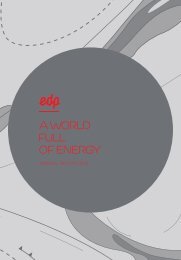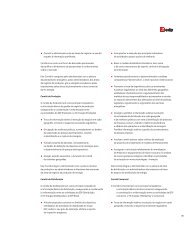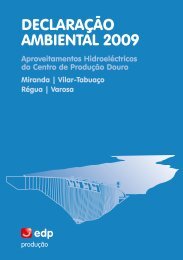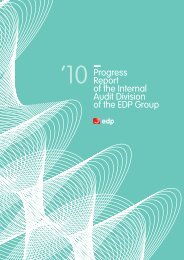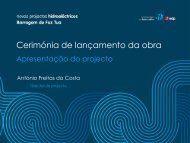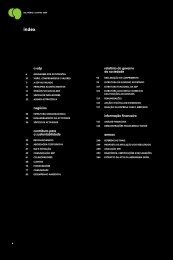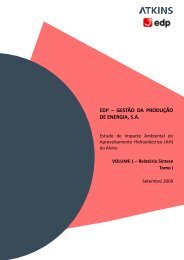Part II - EDP
Part II - EDP
Part II - EDP
Create successful ePaper yourself
Turn your PDF publications into a flip-book with our unique Google optimized e-Paper software.
As a highly significant measure to promote<br />
micro‐generation and energy efficiency, we also<br />
completed a project to supply electricity from a renewable<br />
source to the Sustainability Area at <strong>EDP</strong>’s head office.<br />
The supply comes from a photovoltaic system that operates<br />
independently from the electricity grid.<br />
9.3. Biodiversity<br />
<strong>EDP</strong>’s activities fall within its Biodiversity Policy, which was<br />
published on the <strong>EDP</strong> website in 2007.<br />
Due to the importance of impacts on biodiversity resulting<br />
from the construction and operation of power generation<br />
and distribution infrastructure, <strong>EDP</strong> published a brochure<br />
about the company’s actions in this area. It will be available<br />
on www.edp.pt > Sustainability > Biodiversity in the first<br />
half of 2009 and will complement information given in this<br />
section.<br />
This brochure describes ongoing projects in the B&B<br />
partnership with the Nature and Biodiversity Conservation<br />
Institute (ICNB) and a number of current case studies.<br />
In 2008, the first edition of Biodiversity <strong>EDP</strong> Fund distributed<br />
EUR 500,000 to three different projects selected from<br />
105 high-quality applications.<br />
In electricity distribution in Portugal, <strong>EDP</strong> continued its work<br />
under the Birdlife Agreement, a partnership set up with two<br />
NGOs, Quercus and the Portuguese Bird Society (SPEA),<br />
and the ICNB. The aim of this agreement is to reconcile<br />
quality of service with the protection of birdlife. At the end<br />
of 2008 it had resulted in anti-collision and electrocution<br />
protection in 125 km of overhead lines.<br />
Concerning electricity generation, the third year of the<br />
Plan to Restore Migratory Fish to the Douro Basin was<br />
completed. In spring 2008, 80,000 lamprey larvae were<br />
released on the banks of the River Sousa in order to<br />
repopulate the Douro Basin with sea lamprey.<br />
We returned to the cooperation agreement with INETI, now<br />
called LNEG (National Engineering and Geology Laboratory)<br />
for a project to recover thermal waste in protected<br />
agriculture – the Serra da Arrábida Reforestation Project.<br />
The greenhouses will remain in order to support present<br />
and future activities for the conservation and promotion of<br />
biodiversity.<br />
In Brazil, the monitoring fish life and biodiversity studies<br />
continued along with the restoration of habitats around<br />
some hydroelectric power stations.<br />
Due to the rapid growth in installed wind-power capacity,<br />
32 % of the existing farms, totalling 51, have monitoring<br />
in place.<br />
Offsetting impact in Cloud County,<br />
Kansas<br />
Following a study to assess the ecological impact<br />
of the wind farm in Cloud County, Kansas, in 2008<br />
Horizon Wind Energy committed itself to financing<br />
a volunteer nature conservation programme to<br />
offset any impact resulting from the wind farm.<br />
The agreement, signed by Ranchland Trust of<br />
Kansas (RTK) and Nature Conservancy of Kansas,<br />
covers the investment for a habitat recovery<br />
programme outside the wind farm area in around<br />
8,000 hectares.<br />
<strong>EDP</strong> Management in Classified Areas in 2008<br />
Portugal Spain Brazil USA<br />
Distribution Grids (km)<br />
AT<br />
Overhead 846 38 42 n.a.<br />
Underground 4 0.5 0.1 n.a.<br />
MT<br />
Overhead 7,539 587 3,834 n.a.<br />
Underground 708 23 0.4 n.a.<br />
No. of substations 19 10 20 n.a.<br />
Generation (ha)<br />
Areas flooded by reservoirs (*) 3,426 260 0 n.a.<br />
Areas assigned to wind generation 716 n.a. n.a. 0<br />
(*)<br />
Not including Alqueva and Pedrógão<br />
9.4. Environmental management<br />
<strong>EDP</strong>’s corporate environmental management system<br />
has ISO 14001:2004 certification. It covers corporate<br />
management of environmental policies and strategic<br />
environment plans, environmental information and the<br />
environmental performance of <strong>EDP</strong> Group organisations.<br />
Certification of its corporate environmental management<br />
system has reinforced <strong>EDP</strong>’s commitment to include<br />
environmental aspects in planning and decision-making<br />
processes at all levels, such as the assessment, control<br />
and minimisation of significant impacts arising from its<br />
activities.<br />
Identification of and response to accidents and<br />
emergencies are included in emergency plans and<br />
procedures aimed at the prevention and minimisation of<br />
related environmental impacts. Drills are held to check that<br />
emergencies are identified and dealt with correctly and to<br />
assess response capacity.<br />
The importance of ongoing improvement in environmental<br />
management and eco-efficiency also encourages the<br />
103<br />
Caderno_Institucional_ENG_A4_66-107.indd 103<br />
4/14/09 12:43:42 PM






